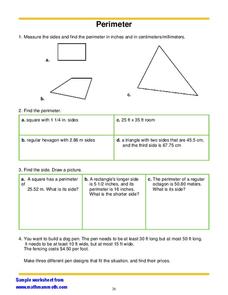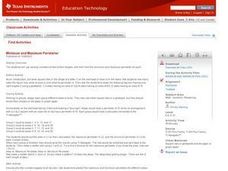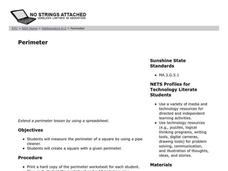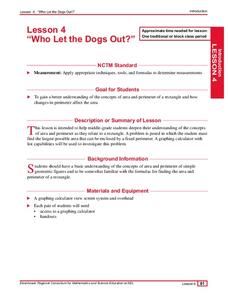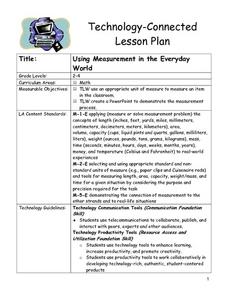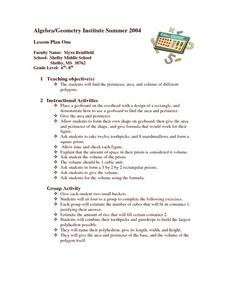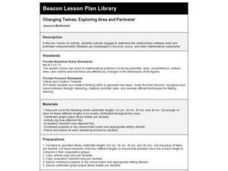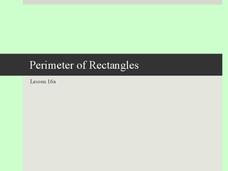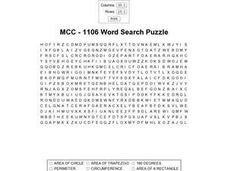Math Mammoth
Area- Perimeter- Volume
In this geometry worksheet, students use a grid to draw 3 different rectangles that have an area of 20 square units and determine the perimeter of each rectangle. They draw and answer questions related to the relationships and uses of...
Curated OER
Perimeter
For this perimeter worksheet, students measure the sides of three triangles to find the perimeter in inches and centimeters. Students find the perimeter of a given square and hexagon as well.
Curated OER
Minimum and Maximum Perimeter
Pupils practice a variety of strategies with varying numbers of tiles to form shapes and then find the minimum and maximum perimeter for each one. Each group is assigned a different area to build either with square tiles or a geoboard....
Curated OER
Balobbyland City Planners
Students create a mini city using proportions that fit a model human they construct using tin foil. They plan the city including a library, sports arena, living spaces, parks and businesses. When constructing the paper buildings, they...
Curated OER
Perimeter
Young scholars measure the perimeter of a square and create squares with specific perimeters in this instructional activity for the early-elementary classroom. The instructional activity includes templates for AppleWorks, Inspiration,...
Curated OER
Who Let the Dogs Out?
Students examine the concepts of area and perimeter and how they relate to a rectangle. They find the largest possible area that can be enclosed by a fixed perimeter and complete a worksheet as well as create a table of all the possible...
Curated OER
Measuring the Area of Polygons
Fourth graders use pattern blocks to explore areas of polygons. They explain that the answers to the area of the same polygon vary according to the units of measurement used. They visualize how different units of measurement can be used...
Curated OER
Rep Tiles
Third graders use pattern blocks of one shape at a time to try to create a similar shape. They compare the perimeter of the new figure with the perimeter of the original shape and look for a pattern. Students use the pattern to predict...
Curated OER
Using Measurement in the Everyday World
Students use an appropriate unit of measure to measure an item in the classroom. They create a PowerPoint to demonstrate the measurement process. Pupils are divided into pairs. Students use a concept map to discuss the terms for...
Curated OER
Around We Go!
Students make accurate measurements and calculations of measuring the area an perimeter of a section of the floor accordingly. They use appropriate measurement and calculation strategies to write a complete a clear explanation for how...
Curated OER
Pumpkins By the Pound
Use pumpkins of various sizes to experiment with weight and perimeter. First the class lifts the pumpkins one by one, estimating each pumpkin's weight. They arrange the pumpkins from lightest to heaviest, and then string weigh each one...
Curated OER
Lesson One: Perimeter, Area, Volume
Students explore perimeter, area and volume. Using geoboards, toothpicks, and marshmallows, students create specific shapes. They are directed to use formulas to find the volume, area, and perimeter of the created shapes. In groups,...
Curated OER
Up For Change?
Students explore similar objects. They participate in a series of hands-on, multimedia and online activities to examine how the edge length affects the angle measures, perimeters and areas of similar regular polygons. Students find the...
Curated OER
Peter's Second String
Fifth graders determine the maximum area and range of areas of a rectangle with a given perimeter. They discuss a word problem involving perimeter and area as a class, investigate the word problem using a piece of string, and in small...
Curated OER
Grade 3: What Can I Make with 30 Centimeters?
Third graders create polygons with perimeters of 30 centimeters, use the centimeter grid paper to determine the area of each shape, and organize the shapes to make generalizations from the patterns they see.
Curated OER
ExplorA-Pond:2nd Grade Perimeter
Second graders visit a real pond. They estimate the pond's perimeter using "student feet." In groups, they measure the pond's perimeter-each group measuring a section of the shoreline. They convert student feet into actual feet and find...
Curated OER
Perfectly Puzzling Pentominoes
Second graders utilize manipulatives (pentominoes) to demonstrate knowledge of: lines of symmetry, slides, reflections (flips), rotations (turns), area, and perimeter. This lesson gives students a meaningful way to practice these...
Curated OER
Changing Twines: Exploring Area and Perimeter
Third graders review formulas for area and perimeter in quadrilaterals. They arrange pre-cut twine on a centimeter graph paper to create non-congruent quadrilaterals. They calculate the perimeter and area of each form.
Curated OER
Introduction to Fractals: Infinity, Self-Similarity and Recursion.
This lesson introduces high schoolers to the ideas involved in understanding fractals. They develop a sense of infinity, self-similarity and recursion and
Curated OER
Length, Perimeter and Area
Learners analyze characteristics and properties of two- and three-dimensional geometric shapes and develop mathematical arguments about geometric relationship
Curated OER
Perimeter of Rectangles
Finding the perimeter of a rectangle is easy, and this presentation gives the formula that makes it so. In this short PowerPoint, learners find the perimeter of a given rectangle, after being coached on how to calculate the measurement....
Curated OER
MCC - 1106 Word Search
Use this geometry instructional activity to have learners locate and identify various vocabulary terms related to mathematics. There are seven words/phrases located in the puzzle.
Curated OER
Luxury Hotel
Give the most important people watching the Olympics a beautiful place to stay! Learners create a luxury hotel for the games using AppleWorks, fractions, and their knowledge of perimeter and area. The math instructional activity includes...
Curated OER
Area and Perimeter of Rectangles
Discover the difference between area and perimeter. Learners are grouped in twos and threes and each group has one advanced/gifted learner to serve as the peer helper. They receive manipulatives to help them determine the area and...



